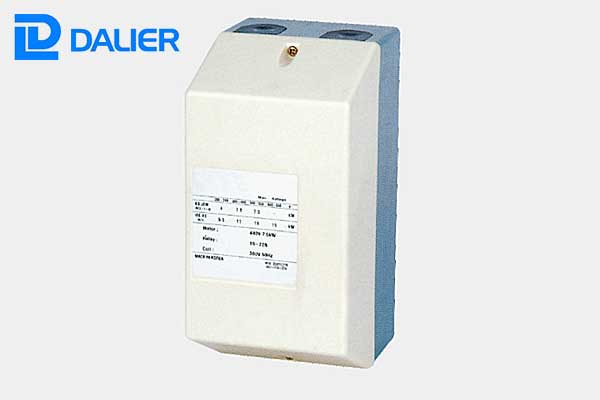What is a thermal relay?
A thermal relay is a type of electrical protection device designed primarily to safeguard electric motors (and other electrical equipment) from damage caused by overload conditions. Unlike circuit breakers or fuses that respond to short circuits (sudden, high-current faults), thermal relays operate based on the accumulation of heat from prolonged excess current—mimicking the thermal behavior of the motors they protect.
At its core, a thermal relay relies on a bimetallic strip (a key component made by bonding two metals with different thermal expansion coefficients) as the sensing elem
1. What Is the Function of a Thermal Relay?
The primary role of a thermal relay is to prevent motor burnout and equipment damage by monitoring current-related heat and interrupting power when unsafe conditions arise. Its key functions include:
Overload Protection (Core Function)
Motors often draw "locked-rotor current" (much higher than rated current) when overloaded (e.g., heavy loads, mechanical jams). Prolonged exposure to this current overheats the motor’s windings, damaging insulation and causing burnout. The thermal relay detects this excess heat and trips to cut off power to the motor.
Phase Failure Protection (Optional)
Many modern thermal relays include a three-phase sensing design to protect against "single-phasing". Single-phasing causes the remaining two phases to carry 1.73 times the normal current, leading to rapid overheating. The relay detects the imbalance in phase currents/heat and trips.
Coordination with Contactors
Thermal relays do not directly switch high motor currents (they are low-current control devices). Instead, they work with a contactor (a high-current switch): when the relay trips, it opens the contactor’s control circuit, which in turn disconnects the motor from the main power supply.
Thermal Matching to Motors
Thermal relays are rated for specific motor power ratings. Their bimetallic strips are calibrated to heat up and trip at a rate that aligns with the motor’s thermal time constant—avoiding false trips from short-term current spikes (e.g., motor startup) while responding to dangerous sustained overloads.
2. Auto Reset vs Manual Reset on Thermal Relays
Thermal relays typically offer two reset modes to restore operation after a trip, each suited to different application scenarios. The table below compares their key differences:
| Feature | Auto Reset (Automatic Reset) | Manual Reset (Hand Reset) |
|---|---|---|
| How It Works | After tripping, the bimetallic strip cools down and automatically returns to its original shape, re-closing the control circuit. | After tripping, the relay remains in the "tripped" position until a user manually presses a reset button to restore the circuit. |
| Application | Unattended systems (e.g., small pumps, fans in remote locations) where brief overloads are temporary and no fault troubleshooting is needed. | Critical systems (e.g., industrial motors, conveyors) where overloads may indicate a serious fault (e.g., jammed machinery) that requires inspection before restarting. |
| Safety | Lower safety: If the root cause of the overload (e.g., a jam) is not fixed, the relay will repeatedly trip and reset, risking motor damage or fire. | Higher safety: Forces users to identify and resolve the overload cause (e.g., clear a jam) before restarting, preventing repeated damage. |
| Convenience | More convenient: No manual intervention is needed for temporary, non-critical overloads. | Less convenient: Requires human effort to reset, which may delay operation if staff are not nearby. |
3. How Does a Thermal Relay Work?
The operation of a thermal relay follows a simple, heat-driven sequence, centered on the bimetallic strip. Here’s a step-by-step breakdown:
Current Sensing
The thermal relay is connected in series with the motor’s power circuit (or in some cases, with current transformers for high-current motors). When the motor runs, current flows through a heating element (a resistive coil) in the relay.
Heat Generation & Bimetallic Strip Deformation
The heating element generates heat proportional to the current (per Joule’s law: Q = I²Rt). This heat is transferred to the bimetallic strip. Since the two metals in the strip have different thermal expansion coefficients, one metal expands more than the other when heated—causing the strip to bend toward the metal with lower expansion.
Trip Action
When the motor is overloaded, the current (and thus heat) exceeds the relay’s rated value. The bimetallic strip bends far enough to push a mechanical trigger mechanism. This trigger opens the relay’s auxiliary contacts, which are part of the contactor’s control circuit.
Motor Shutdown
With the auxiliary contacts open, the contactor loses power and its main contacts disconnect—cutting off the motor’s supply of main power. The motor stops, preventing further overheating.
Reset
After the overload is resolved, the heating element cools down. The bimetallic strip contracts and returns to its original shape:
For auto-reset relays: The strip’s return automatically resets the trigger and closes the auxiliary contacts, allowing the motor to restart (if the contactor is re-energized).
For manual-reset relays: The strip’s return readies the relay, but a user must press the reset button to reclose the auxiliary contacts and enable restart.
4. Advantages and Disadvantages of Thermal Relays
Thermal relays are widely used for motor protection, but they have distinct strengths and limitations that make them suitable for specific scenarios.
Advantages
-
Low Cost & Simple Structure
Compared to electronic protection devices (e.g., motor protection relays with microcontrollers), thermal relays have fewer components (bimetallic strip, heating element, trigger) and are significantly cheaper to manufacture and maintain. -
Thermal Matching to Motors
The bimetallic strip’s heat-driven operation closely simulates the thermal behavior of motor windings. This means it ignores short-term current spikes (e.g., motor startup, which lasts a few seconds) but trips for sustained overloads—avoiding false trips and ensuring accurate protection. -
Reliable Overload Detection
They have no electronic components (e.g., sensors, chips) that can fail due to voltage surges or electromagnetic interference (EMI). This makes them highly reliable in harsh industrial environments. -
Easy Installation & Operation
Thermal relays are compact and require minimal wiring (typically connected in series with the motor and parallel to the contactor’s control circuit). They also have no complex programming—just simple calibration for the motor’s rated current.
Disadvantages
-
Slow Response Time
The bimetallic strip requires time to heat up and bend—meaning thermal relays cannot protect against short circuits (which involve extremely high currents that damage motors in milliseconds). For short-circuit protection, a separate fuse or circuit breaker is always needed. -
Susceptibility to Ambient Temperature
The bimetallic strip’s behavior is affected by the surrounding environment. If the relay is installed in a hot area (e.g., near a furnace), the strip may overheat and trip falsely. Conversely, in cold environments, it may not trip quickly enough during overloads. Some models include temperature compensation (a second bimetallic strip) to mitigate this, but it does not eliminate the issue entirely. -
No Protection Against Other Faults
Beyond overloads and phase failure (in some models), thermal relays cannot detect other common motor faults, such as insulation breakdown, bearing failure, or voltage imbalance. For comprehensive protection, they must be paired with additional devices (e.g., insulation monitors, vibration sensors). -
Limited Adjustability
While basic thermal relays allow calibration for rated current, they lack the flexibility of electronic relays (e.g., adjustable trip delays, digital current monitoring, or remote status reporting). This makes them less suitable for complex motor control systems.
Summary
In short, a thermal relay is a cost-effective, reliable device for protecting motors from sustained overloads. Its heat-driven operation (via a bimetallic strip) aligns with motor thermal behavior, and its auto/manual reset options adapt to different application needs. However, its slow response and sensitivity to ambient temperature mean it must be paired with other devices (e.g., fuses for short circuits) in most industrial setups. It remains a staple in low-to-medium voltage motor protection due to its simplicity and affordability.




